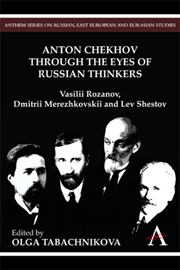 Anton Chekhov Through the Eyes of Russian Thinkers
Anton Chekhov Through the Eyes of Russian Thinkers Book contents
- Frontmatter
- Contents
- Acknowledgments
- Introduction
- List of Names
- List of Russian Cultural Concepts
- Three Brief Biographies – Rozanov, Merezhkovskii and Shestov
- Part One Vasilii Rozanov
- Part Two Dmitrii Merezhkovskii
- Part Three Lev Shestov
- 9 Lev Shestov on Chekhov
- 10 Between Tragedy and Aesthetics: Shestov's Reading of Chekhov – a Gaze Directed Within
- 11 Shestov–Chekhov, Chekhov–Shestov
- 12 Philosophy's Enemies: Chekhov and Shestov
- Notes on Contributors
10 - Between Tragedy and Aesthetics: Shestov's Reading of Chekhov – a Gaze Directed Within
from Part Three - Lev Shestov
Published online by Cambridge University Press: 05 March 2012
- Frontmatter
- Contents
- Acknowledgments
- Introduction
- List of Names
- List of Russian Cultural Concepts
- Three Brief Biographies – Rozanov, Merezhkovskii and Shestov
- Part One Vasilii Rozanov
- Part Two Dmitrii Merezhkovskii
- Part Three Lev Shestov
- 9 Lev Shestov on Chekhov
- 10 Between Tragedy and Aesthetics: Shestov's Reading of Chekhov – a Gaze Directed Within
- 11 Shestov–Chekhov, Chekhov–Shestov
- 12 Philosophy's Enemies: Chekhov and Shestov
- Notes on Contributors
Summary
‘Shestovizing’ Chekhov: Facts, Conjecture and Existential Philosophy
Objectivity pertains to eternity; however, extreme subjectivity defines living beings. As in one of Bidstrup's caricatures, a new hat that has been sat on and crumpled provokes laughter in a sanguine person, and moves a melancholic person to tears. The same blow sounds sharp on glass and muffled on wood, and upon hearing the sound one is able to guess the nature of the material that absorbed the shock. In exactly the same indirect manner, the outside world manifests itself more expressively through indirect rather than direct speech. From this perspective, Lev Shestov's essay on Chekhov, bearing the intriguing title, ‘Creation from Nothing’, is in my view primarily (although not exclusively) a testimony to Shestov himself.
The principal idea of Shestov's essay, which provocatively conceals his more authentic insights into Chekhov's work, is delivered in the opening pages, in Shestov's laconic style: ‘Chekhov was the poet of hopelessness. Stubbornly, despondently, monotonously for almost 25 years, over the whole course of his literary production, Chekhov did only one thing: in one way or another he killed human hope. In my opinion, this is the essence of his creative activity'. Throughout his essay, Shestov circles like a vulture gathering strength over the theme of hopelessness.
- Type
- Chapter
- Information
- Anton Chekhov Through the Eyes of Russian ThinkersVasilii Rozanov, Dmitrii Merezhkovskii and Lev Shestov, pp. 175 - 198Publisher: Anthem PressPrint publication year: 2010


